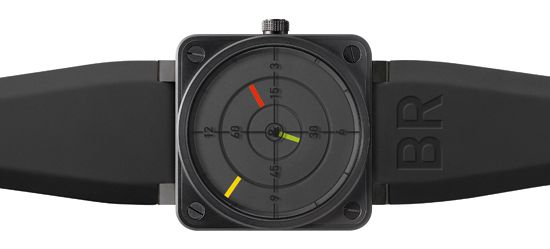With its BR Instrument collection, Bell & Ross has strongly marked out its territory by proposing watches directly inspired by the instrument panel of an airplane. Its square form marked with four screws, even though quickly copied, has done much for the recognition of a brand whose development has been remarkably consistent.
The BR Instrument line was rapidly expanded. After the enormous initial 46-mm BR 01, other Instruments were launched: the 42-mm BR 03; a BR 01 Tourbillon; a BR Minuteur; and even a ‘small’ 39-mm BR-S.

With the all-new BR 01 RADAR, Bell & Ross has taken another step in its integration of aeronautical codes into watchmaking. The RADAR draws its design directly from the sweeping beams of radar screens used in aeronautics. This type of display, besides its technical aspects, offers immediate readability and reliability that are vital in aviation.
We have already seen in the watch world the many attempts to transform the way time is read, among them, notably, replacing the hands with coloured discs. Yet up to now, none of these experiments has achieved any real commercial success. With the BR 01 RADAR, it is different, for two reasons. Not only is this watch perfectly matched to its natural universe—aviation—but, thanks to the intuitive reading of the time—a great advantage of analogue watches—it is perfectly respectful as a timepiece once the very simple code has been understood.
In place of the hands, there are three concentric and independent discs on which three bright colour segments ‘sweep’ the dial. The hours are in yellow, minutes in red and seconds in green. Bell & Ross chose to reposition the hours, minutes and seconds in descending order so that the eye is directed towards the centre of the target-shaped dial. Admittedly, the eye is used to seeing a longer minute hand, but to put the minutes on the outer disc would have required a radical change to the positioning of the gear train, which in turn would have incurred tremendous additional costs. Bell & Ross wanted to keep the price competitive, and besides, once the technique is understood, telling the time is immediate as it is natural.

These three discs must be adjusted to the nearest micron so that they are constantly parallel and the risk of friction is reduced. Another difficulty the Bell & Ross watchmakers had to overcome was the weight of these discs. After a number of trials, metal proved to be too heavy, compromising the quality and the precision of the movement, so a new solution was found with acrylic discs to keep the 42-hour power reserve of the ETA automatic mechanical movement that drives the ensemble. The result is a watch whose great and basic sobriety takes on a certain lightness thanks to its colours and unceasing movement.
The Instrument BR 01 Radar is available in a limited edition of 500 timepieces, in a 46-mm case made of 316L glass bead-blasted stainless steel with a vacuum carbon black finish. Water-resistant to 100 metres, the under-water reading of its colours must be amazing.
Source: Europa Star April - May 2010 Magazine Issue





